The Smithsonian has an excellent, interactive, family tree for humanity that goes back 6 million years.
io9 has a neat image of key primate and homonid skulls that show the story of human evolution, and how we know about it.
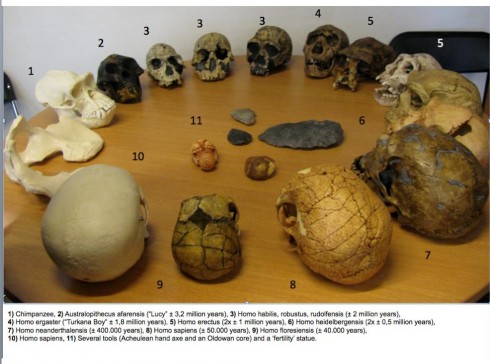
Middle and High School … from a Montessori Point of View
The Smithsonian has an excellent, interactive, family tree for humanity that goes back 6 million years.
io9 has a neat image of key primate and homonid skulls that show the story of human evolution, and how we know about it.

Boys tend to be better at math. That’s been the stereotype, but a new study (Kane and Mertz, 2011) published in the Notices of the American Mathematical Society provides evidence that, at all levels, it’s only because society and culture tend to support, and advance the stereotype.
… we conclude that gender equity and other sociocultural factors, not national income, school type, or religion per se, are the primary determinants of mathematics performance at all levels for both boys and girls. … It is fully consistent with socioeconomic status of the home environment being a primary determinant for success of children in school.
— Kane and Mertz, 2011: Debunking Myths about Gender and Mathematics Performance in Notices of the American Mathematical Society.
Kane and Mertz compared math achievement in a number of countries. If there were some genetic reason for different math abilities then boys should be better than girls everywhere. This is not the case. In more wealthy countries where there is more equality between the genders, the mathematics performance gap disappears.
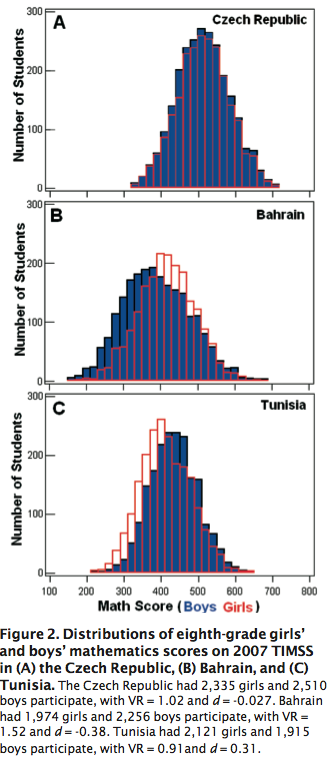
… people learn a visual task better when it’s accompanied by sound, for instance — even when they are later tested using only vision.
— Humphries, 2011: The new science of our cross-wired senses in The Boston Globe.
What I think this means, is that there is now scientific evidence to support the widespread use of sound effects in lectures/presentations. Woohoo!
For the educator, the interaction between sound and vision is one of the fascinating findings of recent research on how our senses interact (see also the work of the Visual & Multisensory Perception Lab). It seems to add some support to the arguments for multimodal learning; rather than just targeting specific learning styles — auditory vs visual vs kinetic etc.– to specific people, including multiple styles of information should help everyone learn better.
But beyond just education a better understanding of how the senses interact has a lot of implications.
… what people saw affected what they heard; that certain types of music or background noise affected how food tasted; and that smells could influence how a texture felt to the touch.
— Humphries, 2011: The new science of our cross-wired senses in The Boston Globe.
This research is already affecting how things are marketed and presented to us.
A study published this year showed that people thought a strawberry mousse tasted sweeter, more intense, and better when they ate it off a white plate rather than a black plate.
— Humphries, 2011: The new science of our cross-wired senses in The Boston Globe.
This research is also pertinent to the issue of Sensory Integration Disorder, which, by some estimates, affects somewhere between 1 in 6 and 1 in 20 children.
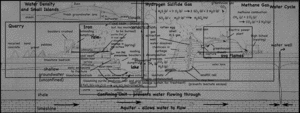
A single, half-day, visit to the landfill and quarry brought up quite the variety of topics, ranging from the quarry itself, to the reason for the red colors of the cliff walls, to the uses of the gases that come out of the landfill. I still have not gotten to the details about the landfill itself, but I’ve put together a page that links all my posts about the quarry and landfill so far.
There was so much information that we spent the better part of the following week debriefing it in the middle-school science class.
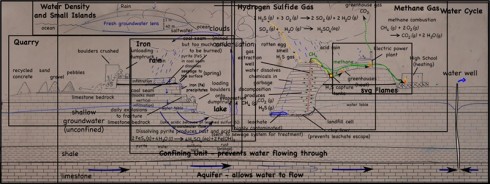
The map below gives a good aerial view of the site.
View Landfill and Quarry (as of 11/26/2011) in a larger map
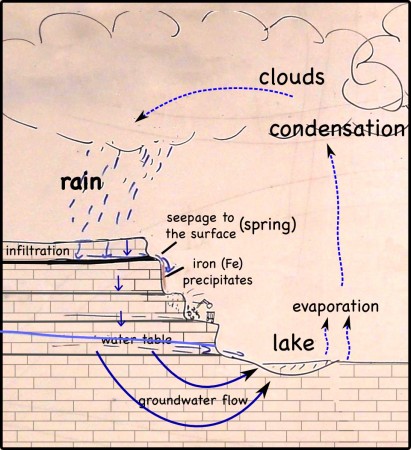
The water cycle is intricately tied to all the other topics that came up on our visit to the quarry/landfill. For some things, the tie to water is direct and inextricable.
For other things the link to water is not necessarily so obvious:
The water cycle picture starts simply, but gets complicated very quickly.
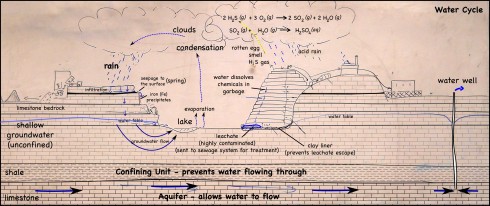
Dan Frommer has posted a guide called, “10 steps to better blogging“. His rules are aimed at commercial bloggers/journalists, but even for the hobbyist/student there are some noteworthy points (certainly ones I try to follow):
Most of these are just the basic elements of good writing.
I’d also suggest that it’s important to include your perspective wherever you can. There are a number of great places that aggregate a lot of good information, but for the aspiring writer, adding your unique point of view should help find your voice.
(found via The Dish).
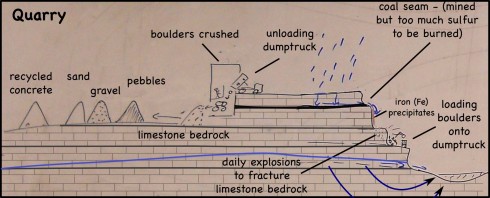
The landfill/quarry we visited was originally a limestone quarry; once they had the hole in the ground they needed to fill it with something so why not trash (and why not get paid to fill it).
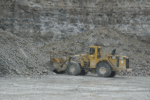
The limestone bedrock is blasted daily to create some massive boulders. The boulders are then loaded on some equally massive dumptrucks. There are scarce few minutes between trucks, so a lot of rocks are being moved.
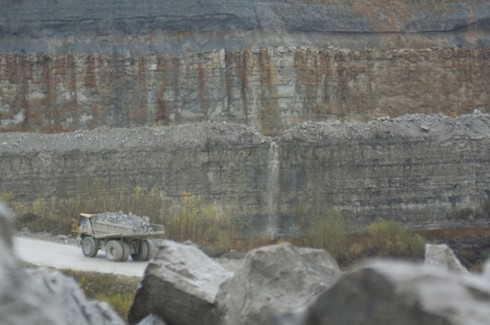
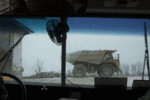
The trucks then dump their load into a large building where the rocks are crushed. Our guide made us stop the bus to watch the process. While watching a dumptruck unloading might seem mundane, the enormous size of the truck and its boulder load did seem to captivate the students.
Once the rocks are crushed, the resulting sediment is sorted by size (sand, pebbles and gravel, I think) and piled up. The piles are massive. I’ve been wanting a good picture that shows the angle of repose; I got several.
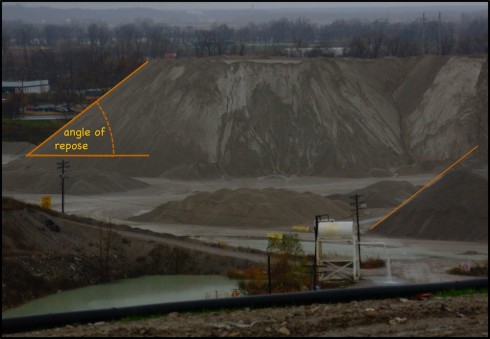
The pebbles and gravel are used for road construction and provide a matrix for concrete.
Since limestone dissolves fairly easily in rainwater, the sand-sized and smaller particles (< 2mm diameter) aren't used for construction -- hard, insoluble quartz sand is preferred.
Limestone: calcium carbonate (CaCO3)
However, the limestone sediment piles sit out in the open and some the finer grains (silt sized particularly), and any dissolve calcium carbonate, get washed into the nearby ponds, which turn a beautiful, bright, milky green.
Finally, in addition to the limestone sediment piles, there is also one enormous pile of broken up concrete. One of the things that stuck with the students was that fact that you can recycle concrete.

One of the questions that came up when we were talking about dealing with the highly contaminated leachate that drains out of landfills, is what would happen to it if it was just put into a lake or the ocean. Would the liquid just mix into the water, or would it stay separate.
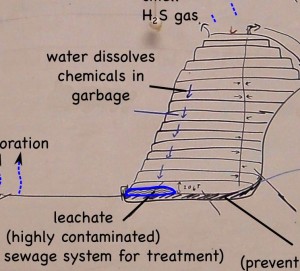
I’m afraid I did not go with an easy answer. It depends after all on two things: how different the density is of the leachate from seawater; and how turbulent is the water.
Turbulent water will make the leachate more likely to mix, while a greater density difference would cause them to “want” to remain separate. An extremely dense leachate might just settle to the bottom of a lake and stay there.
One example of two fluids that are in contact but stay separate is in the groundwater beneath small islands. Rain water falls on the island and seeps into the ground. It’s fresh, but the water in the surrounding ocean and the water that’s already underground are both salty. Salty water is more dense than the fresh so the freshwater will float on top of the salty water creating a thin lens.
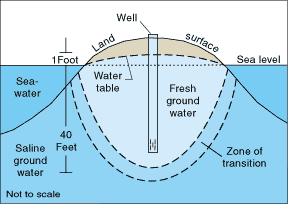
How thick is the lens? For every meter that the fresh groundwater is above sea level, there are 40 meters of fresh water below sea level (1:40). This is because saltwater has density of about 1.025 g/cm3, while freshwater has a density of about 1.000 g/cm3 (note that I use four significant figures in each of these values).
The freshwater lens can be a great source of drinking water on these isolated small islands, but like the islands themselves, they are threatened by rising sea levels due to global warming.